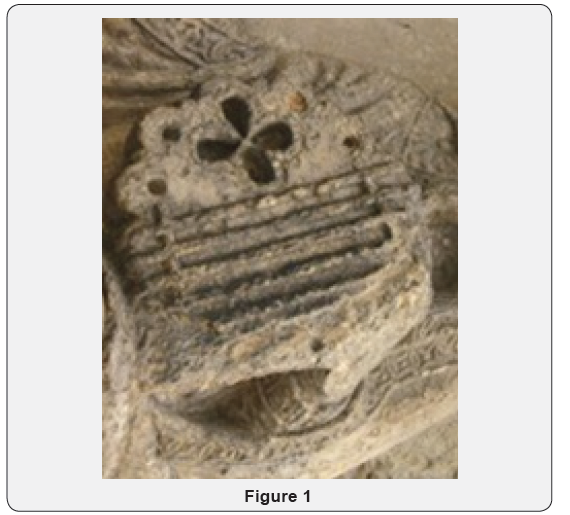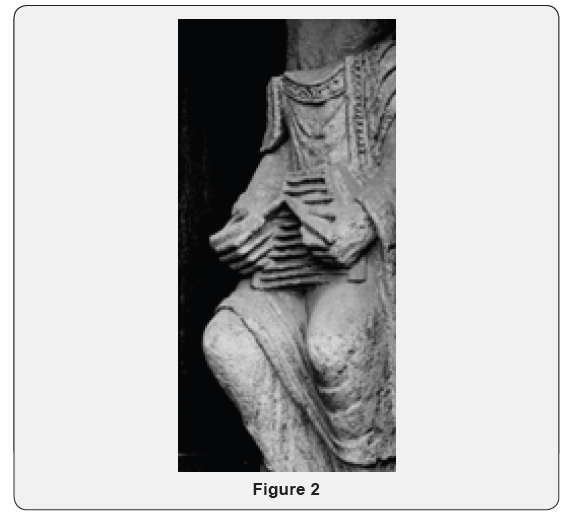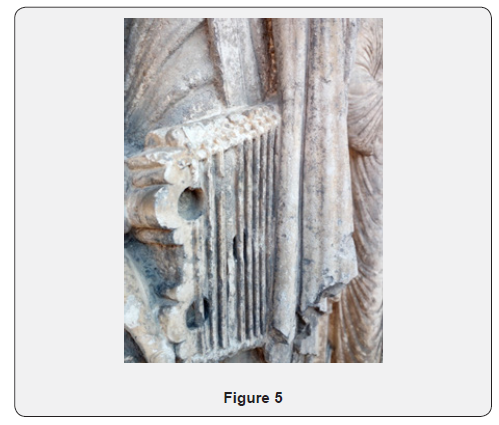Psalteries of the Royal Door Gate (1144) of the Cathedral of our Lady of Chartres- Juniper Publishers
Archaeology & Anthropology- Juniper Publishers
Opinion


In the south door gate of Chartres Cathedral, called
Royal, there are four depictions of Psalteries. The first instrument,
very damaged, has 5 strings passing over two almost parallel bridges
(Figure 1). The second psaltery has ten strings, the angles between the
bridges and the strings being of 72° (Figure 2) The two main psalteries,
that of the first Elder of the Apocalypse
(Figure 3) and that of the Music (Figure 4), share the same structure:
nine pairs of strings form with the bridges a regular trapezium, the
angles at the base of 72° [1]. The first psaltery has a tenth pair of
strings, well hidden under the mantle of the Elder, invisible from below
(Figure 5). The other psaltery has nine pairs of strings, although
there would be room for a tenth (Figure 6).




In contemporary texts the name Psalterium decachordum,
from the Old Testament, Psalm 32 is frequently used. Saint
Jerome (Epistula ad Dardanum) states that the adjective
decachordum refers to the moral law: the Decalogue. One
wonders why to represent with nine strings instruments which
as usual had ten, in addition to put them in great evidence in
the hands of the first Elder of the Apocalypse and in the allegory
of the Music represented among the Liberals Arts. To answer
this question, one must consider the different points of view of
the medieval public. Illiterate visitors see instruments and do
think about Celestial Music. The illiterate musicians recognize
the instruments and perhaps count the strings: they think of an
error or a novelty in the music. Visitors trained into the Liberal
Arts know that the Nine can have different meanings. The
Orthodox Catholic vision as the successor of Isidore de Séville,
considered the Nine to be imperfect compared to the Ten (Liber
numerorum qui in sanctis scripturis occurrunt 10.52.PL 83: 190).
In this case, the nine strings could be related to the imperfection
of our musical knowledge, mentioned by Musica enchiriadis (XIX,
10-12) and Micrologus (XIV, 16-19). Pythagoras, who was sitting
close, had stated the perfection of Ten in Tetraktys. Nevertheless,
in musical tradition the Nine, in the fundamental ratio 9/8, is
considered “omnium musicorum sonorum mensura communis”
(Boethius, Arithmetica 2,54, CCL 94 A: 224). 9/8 is the
fundamental cosmological ratio in Plato’s Timaeus, whose ideas
were transmitted by Cicero, Macrobius and Calcidius. Marcianus
Capella affirms that number Nine “harmoniae ultima pars est”
(Nuptiis Philologiae et Mercurii 7.741). In the twelfth century
Magister Johannes of Seville in his Liber Alchorismi de pratica
aritmetice, translation of the lost book of Muhammad ibn Musa
al-Kwarizmi, introduces the Indian numeration. He explains that
“ergo constat unumquemque limitem 9 numeros continere”, he
recalls that nine are the celestial spheres and nine the angelic
choruses [2]. William of Conches in his work Philosophia gives
no importance to the Ten, while nine are the invisible circles
of heaven (Liber II, V, 13) and nine months of human gestation
(Liber IV, XIV, 22-23). Finally, the most awesome visitor could
have observed that the ratio between the first and the last pair of
strings (hidden or virtual) is 3/2, the right Fifth, the fundamental
harmonic ratio in pythagorean musical theory. Thus, the learned
man could interpret the nine strings of the psalteries as a symbol
of the foundation of harmonic science and at the same time of
the imperfection of our musical knowledge.
To know more about Journal of Archaeology and Anthropology: https://juniperpublishers.com/gjaa/index.php




Comments
Post a Comment